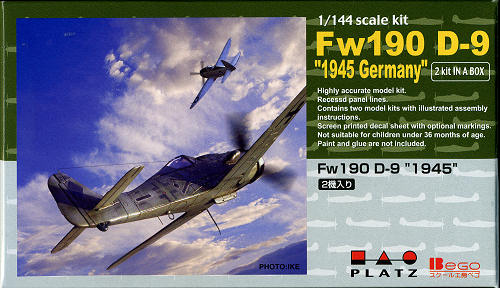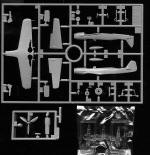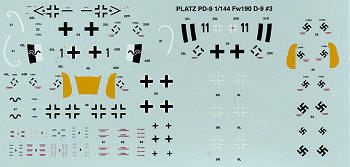
Platz 1/144 FW-190D-9 "1945 Germany"
| KIT #: | PD-9 |
| PRICE: | 1200 yen |
| DECALS: | Three options |
| REVIEWER: | Scott Van Aken |
| NOTES: | Two complete kits |

| HISTORY |
The Fw 190 D (nicknamed the Dora; or Long-Nose Dora, "Langnasen-Dora") was intended to improve on the high-altitude performance of the A-series enough to make it useful against the American heavy bombers of the era. In reality, the D series was rarely used against the heavy bomber raids, as the circumstances of the war in late 1944 meant that fighter-versus-fighter combat and ground attack missions took priority. A total of 1,805 D-9s were produced. Production started in August 1944 with the variant entering Luftwaffe service in September 1944 with III./JG 54.
The liquid-cooled 1,750 PS (1,726 hp, 1,287 kW) Jumo 213A could produce 2,100 PS (2,071 hp, 1,545 kW) of emergency power with MW 50 injection, improving performance to 426 mph (686 km/h) at 21,650 ft (6,600 m). Early D-9s reached service without the MW 50 installation, but in the meantime Junkers produced a kit to increase manifold pressure (Ladedrucksteigerungs-Rüstsatz) that increased engine output by 150 PS to 1,900 PS, and was effective up to 5,000 m (16,400 ft) altitude. It was fitted immediately to D-9s delivered to the units from September, or retrofitted in the field by TAM. By the end of December, all operational Doras, 183 in total, were converted. From November 1944, a simplified methanol-water (MW 50) system (Oldenburg) was fitted, which boosted output to 2,100 PS. By the end of 1944, 60 were delivered with the simplified MW 50 system or were at the point of entering service. The 115 L tank of the Oldenburg system would hold the MW 50 booster liquid, which was single-purpose, while later systems were to be dual-purpose, holding either MW 50 or additional fuel.
Historian Donald Caldwell noted:
The new airplane lacked the high turn rate and incredible rate of roll of its close-coupled radial-engined predecessor. It was a bit faster, however, with a maximum speed of 680 km/h (422 mph) at 6,600 meters (21,650 ft). Its 2,240 horsepower with methanol-water injection (MW 50) gave it an excellent acceleration in combat situations. It also climbed and dived more rapidly than the Fw 190A, and so proved well suited to the dive-and-zoom ambush tactics favored by the Schlageter pilots. Many of the early models were not equipped with tanks for methanol, which was in very short supply in any event. At low altitude, the top speed and acceleration of these examples were inferior to those of Allied fighters. Hans Hartigs recalled that only one of the first batch of Dora-9s received by the First Gruppe had methanol-water injection, and the rest had a top speed of only 590 km/h (360 mph).
Due to the failure of multiple attempts to create an effective next-generation 190, as well as the comments of some Luftwaffe pilots, expectations of the Dora project were low. These impressions were not helped by the fact that Tank made it very clear that he intended the D-9 to be a stopgap until the Ta 152 arrived. These negative opinions existed for some time until positive pilot feedback began arriving at Focke-Wulf and the Luftwaffe command structure. Sporting excellent handling and performance characteristics, it became very clear that the D-9 was nearly the perfect response to the Luftwaffe's need for an effective medium altitude, high-speed interceptor, although its performance still fell away at altitudes above about 20,000 ft (6,100 m). When flown by capable pilots, the Fw 190D proved to be a match for P-51s and Mk. XIV Spitfires. Lt. Karl-Heinz Ossenkopf, a fighter pilot of JG 26 with five months of frontline service, commented on the aircraft:
The Fw 190 D-9 was quickly adopted by the pilots, after some initial reservations. They felt that it was equal to or better than the equipment of the opposition. Its servicability was not so good, owing to the circumstances. I felt that the aircraft built at Sorau had the best fit and finish. They could be recognised by their dark green camouflage. I hit 600 km/h with my "own" green aircraft, "Black 8", with full power and MW 50 methanol injection, clean, 20-30 meters above the ground.
| THE KIT |
 Platz
and Sweet are the two major forces in quality 1/144 injection molded combat
planes. One of Platz's earlier kits was the FW-190D-9 and judging by how they
release things, it was natural to find it in a second boxing, this time with
different markings. Thanks to the demand, this kit has been reissued.
Platz
and Sweet are the two major forces in quality 1/144 injection molded combat
planes. One of Platz's earlier kits was the FW-190D-9 and judging by how they
release things, it was natural to find it in a second boxing, this time with
different markings. Thanks to the demand, this kit has been reissued.
The kit is superbly detailed with an nicely done cockpit (not that you can see much of it even in larger scales), an under fuselage rack and drop tank, as well as both styles of canopy that were provided for the 190D-9. The kit even includes the very thin morane antenna that was fit to the lower fuselage. Landing gear are also nicely formed with proper retraction struts.
 The kit's
instructions are quite well done with little notes about what goes where and
five nicely drawn construction steps. There is a full stencil application guide
that includes variants on the drop tank markings. Three markings options are
given. First is the box art plane from 2./JG 26 in May 1945. This one has the
later canopy and is painted in RLM 75/83/76. Next is from 14./JG 26 in RLM
82/83/7 with a yellow rudder and lower cowling. It also has the units Reich
Defense band in black and white. The final option is from JG.4 in RLM 75/83/76.
This has JG 4s Reich Defense band. The decals are superbly printed and provide
all the insignia and data markings you will need.
The kit's
instructions are quite well done with little notes about what goes where and
five nicely drawn construction steps. There is a full stencil application guide
that includes variants on the drop tank markings. Three markings options are
given. First is the box art plane from 2./JG 26 in May 1945. This one has the
later canopy and is painted in RLM 75/83/76. Next is from 14./JG 26 in RLM
82/83/7 with a yellow rudder and lower cowling. It also has the units Reich
Defense band in black and white. The final option is from JG.4 in RLM 75/83/76.
This has JG 4s Reich Defense band. The decals are superbly printed and provide
all the insignia and data markings you will need.
| CONCLUSIONS |
Another superb offering from the folks at Platz. Like all of the Platz kits, you get two complete aircraft. Painting the mottling on this one will be fun!
| REFERENCES |
http://en.wikipedia.org/wiki/Focke-Wulf_Fw_190
September 2011
My thanks to www.platz-hobby.com for the preview kit. Get yours at your local shop or have them order it for you.
If you would like your product reviewed fairly and quickly, please contact me or see other details in the Note to Contributors.